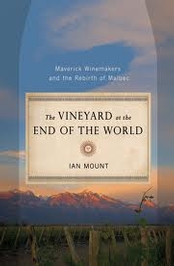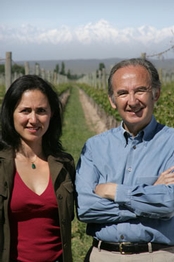Wine books are everywhere. And like most books published today, a few are good, many are average and moderately useful, and about the same number are not worth your time. At the top of a list of wine-book criticisms: The material has been covered many times before, there are usually too many facts with which the author has played fast-and-loose, and most  egregious of all, by the time the majority of wine books reach the public, most are out of date.
egregious of all, by the time the majority of wine books reach the public, most are out of date.
Occasionally a very readable wine book with an historic bent slips through, such “Vineyard at the End of the World,” an account of the Argentine wine industry by Ian Mount, an American writer living in Buenos Aires. Mount has tackled a subject that arguably does not have wide appeal, except maybe to the small insular wine crowd. And he does it with skill, patience, heavy research and an obvious love of the subject. He conducted more than 125 interviews and has included an extensive selected bibliography and copious notes on each chapter. Full disclosure: I was one of the writers interviewed by Mount for this book.
In the Introduction and first two chapters, the author sets the stage for the birth of the Argentine wine industry with a bit of history, including “The Immigrants,” an account of early European settlers who fathered Argentine wines, an account that bears a close similarity to the history of California wine. General Rufino Ortega, a soldier who rose to become the governor of Mendoza in the late 19th century, is not unlike Sonoma’s own Colonel Agostan Harazthy.
Mount’s story of modern Argentine wine gets rolling in Chapter Three, “La Crisis,” an insightful post WWII tale of intrigue, economic shenanigans connected to powerful banks (sound familiar?), military involvement, family fights over who rules the growing wine business and more. Then the author leapfrogs in time, going from 1948 to 1979, to arrive at the first mention of Nicolas Catena, a central figure in the growth and direction of the Argentine wine business, up to and including the present.
While spending time as an economics lecturer at UC-Berkeley, Catena took his young family on weekend jaunts to the nearby Napa Valley. It was that experience, coupled with the results of the famous 1976 Paris Tasting that nurtured Catena’s vision for a wine renaissance in Mendoza. And for that he needed outside help, in the person of international wine personalities, including the ubiquitous French consultant, Michel Rolland and Paul Hobbs, a young California winemaker. These men recognized the potential of Argentine wine and the vision of leaders like Nicolas Catena, the Etchart family and later Donald Hess, Jess Jackson, the Rothschild family, among others. They also knew that bringing Argentine wine up to speed wouldn’t be easy.
I spent a lot time visiting wineries in Chile and Argentina in the 1990s and it was at Catena where I first met Hobbs. I knew Hobbs from Sonoma County but was surprised to find him in such a prestigious position in Mendoza. On one visit to the Catena winery, I noticed people like the outspoken viticulturist Pedro Marchevsky and noted enologist, Jose “Pepe” Galante, defer to Hobbs. In his many interviews, Mount discovered aspects of Hobbs’ personality that I never saw, including Hobbs’ criticisms of the vineyards and the wine that didn’t sit too well with either Marchevsky or Galante.
There is this odd disconnect that all writers experience where they sense that the people they interview never tell the whole story. For instance, Mount goes into great detail outlining the father-son relationship that developed between Nicolas Catena and Paul Hobbs. By nature,  Nicolas Catena is a quiet reserved man, though Mount says that he could be very stubborn and forceful, so that side of Catena, and more specifically, his close relationship with Hobbs, was never evident to me. Another thought that I could never pin down was how Catena’s children (his daughter Laura is an executive in the family company) felt about their father’s closeness to this North American.
Nicolas Catena is a quiet reserved man, though Mount says that he could be very stubborn and forceful, so that side of Catena, and more specifically, his close relationship with Hobbs, was never evident to me. Another thought that I could never pin down was how Catena’s children (his daughter Laura is an executive in the family company) felt about their father’s closeness to this North American.
Argentina went through a roller coaster ride in the 1990s, attempting to find a place in the market while slowly improving wine quality. A number of consultants came and went, including Jacques Lurton of the noted Bordeaux wine family and, eventually, Marchevsky and others learned how to beat the heat of the Mendoza high desert by climbing the eastern foothills of the Andes to plant their vineyards. For Catena, it was a decision that paid off. He had Marchevsky supplying the grapes and Hobbs and Galante making the wine. The idea to use altitude to temper the heat proved to be good for their entire Mendoza wine community.
Experiments with a wide range of grapes planted at higher altitudes was mixed, but the one variety that thrived was Malbec, the orphan red grape from Bordeaux that eventually helped Argentina carve out a big slice of the international wine market. Mount closes out his book with the story of “Discovering Malbec” and a summary paragraph of what he calls “The New Princes of Argentine Wine,” like Santiago Achaval, Donald Hess and his high altitude Colome project, Jose Alberto Zuccardi, Paul Hobbs’ Vina Cobos and Susana Balbo, among others in a growing community of new Argentine wineries in Mendoza and the Uco Valley and the northern region of Salta.
A few people I spoke to say that the full story of Argentine wine has yet to be written. True or not, Ian Mount has provided an account that is quite good. A small criticism is the amount of attention Mount pays to Catena and Hobbs, while other important figures in Argentine wine get a shorter shrift. And given the association of Argentina and Malbec in the international wine market, bringing the success of Malbec into the story earlier would have helped the reader. Overall, though, Ian Mount’s story of the Argentine wine industry is well written and a good read, a book that should be in every wine lover’s library.
The Vineyard at the End of the World, Ian Mount, Norton, hardcover, 350 pages, $26.95.
6
